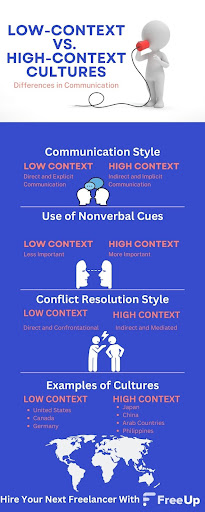

Quick Links
Quick Links
Across the web, there are around 1.5 million Filipino freelancers registered on international online platforms as freelancers. As the ability to hire digitally grows, it opens more and more doors for freelancers and companies.
There are unique benefits to working as a freelancer on the international platform, and there are benefits for the companies that hire these freelancers as well. Filipino and American cultures share many similarities, but there’s no denying there are differences as well.
Understanding some of these differences can help when working with a freelancer from a different culture. Keep reading to learn more about what differences you could encounter when working with freelancers from the Philippines.
Communication Styles
Americans tend to be direct. This isn’t the case for everyone, but for a large part of the population, it is. In American culture, there’s a tendency to say what you mean and cut to the chase.
This type of communication is highly valued by many people. However, it’s a type of communication that can be a struggle for some Filipino freelancers. That’s because Americans exist within a low-context culture, while like other Asian cultures, Filipinos tend to be high context cultures.
High-Context vs. Low-Context Cultures
High-context cultures rely heavily on contextual cues, such as body language, tone of voice, and shared experiences, to convey meaning. These cultures tend to be more collectivist and value relationships over status or individual achievement. Examples of high-context cultures include:
- Japan
- China
- Philippines
- Arab countries
Low-context cultures, on the other hand, are more direct and explicit in their communication. They rely less on contextual cues and more on the literal meaning of words. These cultures tend to be more individualistic and value status and individual achievement over relationships. Examples of low-context cultures include:
- The United States
- Germany
- Switzerland
What Does This Mean When Communicating With Your Freelancer?
If you’re an American, it’s likely that you’re used to a direct style of communication. When working with some from a high-context culture you’ll notice that the communication might not be as direct.
Keep in mind that this will vary from person to person since we’re all unique individuals. People from high-context cultures may explain things more slowly.
It’s the difference between taking the highway versus the scenic route when you’re driving. The highway is more direct and you get there quickly. The scenic route will have a lot of stops along the way, but ultimately you end up in the same place.
You might also notice that freelancers from a high-context culture hesitate to give their real opinion when you ask for feedback. Instead of outright saying no, they may say I’ll try or I’ll do my best.
It’s important to pay attention to non-verbals and context when having conversations with freelancers from high-context cultures. In addition, pay attention to how you communicate as well.
While many freelancers are used to working with clients with different communication styles, they may struggle with more direct communication. Some people from high-context cultures find direct communication uncomfortable or impolite.
How Do You Address This Difference?
Communication differences can feel scary and it can make you feel like you’re walking on eggshells. But, you don’t need to feel that way. We have some more specific tips for you.
Nonverbal Cues Are Key
Nonverbals are a challenge to understand when you’re working remotely. However, when you’re in a video call you can catch some of those nonverbal cues.
Pay attention to body language and pauses. If you’re speaking via a chat platform pay attention to emojis used. Keep in mind, in different cultures emojis can have different meanings.
Build a Relationship and Encourage Open Communication
We all have the ability to alter our communication style to match the person we’re talking to. When you take the time to build a relationship the other person can learn your communication style and understand how to function within it.
In addition, encouraging open communication can help with getting feedback and opening the door for conversations.
Manners and Hierarchy Are Important
From a young age, Filipinos are taught to respect their elders. They use a variety of different titles to honor people who are higher than them in the hierarchy or are older.
It’s similar to being called sir or ma’am in the United States. You might even notice that your freelancer addresses you as sir or ma’am when you first start working together. If you would prefer your first name to be used, just let them know!
Keep in mind that calling you sir or ma’am is simply a way to show respect for your position.
Filipino Freelancers May Avoid Conflict
Conflict isn’t fun for anyone; however, the Filipino culture values harmony making conflict even more challenging. Like many Asian countries, the Philippines is a collectivist culture.
That means that the well-being of the group comes first. Because of this, they may avoid any confrontation or conflict in order to keep the peace.
But as most know conflict and confrontation is not always avoidable, and sometimes it can actually drive change and be a good thing. There are some things you can do to make it easier.
First, anytime you need to give feedback, do so privately. How you give constructive feedback is always important and should always be done in a 1:1 setup. However, here it’s even more important.
Also, make sure you get buy-in when giving this feedback.
Next, provide opportunities for your freelancers to give feedback where their name isn’t attached. This can include anonymous surveys or forms.
Finally, phrase your requests as a question. This can make it seem less direct and help you get the buy-in you need.
Holidays and Family in the Philippines
Your Filipino freelancer will likely celebrate many more holidays than you’re used to. One holiday you might want to take note of is 13-Month Pay. This is a Christmas bonus in Filipino culture.
It’s not required, but it does help you with building a good relationship with your freelancer. Take the time to ask your freelancer about holidays they celebrate and when they may need time off for these.
Filipino freelancers are also very family oriented. You might notice that your freelancers live in multi-generational households. For most Filipino freelancers work is a way to provide for their family.
How Are Filipino and American Work Cultures Similar?
It’s important to note that while there are differences between the two cultures, there are also similarities. For example, Americans also tend to value family and holidays (Americans just might not celebrate as many). Americans also tend to honor elders.
There are certain differences; however, you can still understand the culture because small pieces of it are the same.
Here are some other ways the two cultures are similar:
Multicultural Diversity
There’s a reason that America is called the melting pot. The United States is made up of many cultures and because of that, it provides different perspectives.
Many Americans speak more than one language or come from culturally diverse backgrounds. Because of this, the biggest similarity you see between American and Filipino cultures is that they’re multilingual. Many people speak more than one language fluently.
No Staring
In some cultures eye contact is different. However, both Americans and Filipinos agree on one thing: they don’t like being stared at.
Education
Both Americans and Filipinos value education. In fact, you’ll find that many Filipinos who have immigrated to the United States achieve even higher levels of education.
Filipinos also have a strong grasp of the English language. It’s one of the primary languages in the country. Many of the schools also teach in English making it required to be successful in school.
Work Ethic
Americans often take less vacations and work longer hours than other countries. Culturally there is value placed on working hard to achieve your goals.
One thing you’ll notice is that people from the Philippines also have a very strong work ethic. They often work long hours and will work extra to help others. Part of this is the strong drive to provide for family.
Remember, the Philippines is a collectivist culture. This means that they value the well-being of the group, and if working extra will help, they’ll do that.
Create a Successful Relationship With Your Filipino Freelancer
While there are many similarities between Filipino and American culture, there are also some differences you need to be aware of. Knowing the differences and how to address them will help you create a successful relationship with your Filipino freelancer.
Are you ready to hire a freelancer for your project? Whether you’re looking for someone international or in the US we’ll help you find the right freelancer. Schedule a consultation with one of our experienced account managers to get started.

